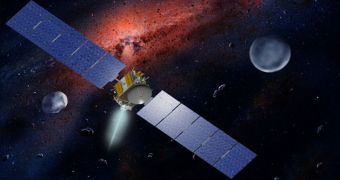Today, November 14, the NASA Dawn spacecraft entered the inner asteroid belt of our solar system for the last time. The probe is scheduled to visit the dwarf planet Ceres, and also the large asteroid Vesta, and to collect scientific readings on as many of the objects' properties as possible. The asteroid belt lies beyond the orbit of Mars, and features millions of space rocks of various sizes that were created shortly after the Sun was born, but that didn't have the correct conditions to come together, and form a larger planet. They are, in the strictest sense of the word, leftovers of our solar system's infancy.
There are two asteroid belts within our solar system. The second one is the Kuiper Belt, which starts around the orbit of Pluto, and that also features a number of dwarf planets, large asteroids, comets and smaller meteorites. A number of interesting celestial bodies can be found inside, such as Haumea, Makemake, Sedna and Eris. Some of them feature eccentric properties, such as Haumea's orbit and shape. Pluto, now regarded by the International Astronomical Union (IAU) as a dwarf planet, is currently in the same class as a few of the aforementioned bodies.
Dawn's job is to analyze this type of structure, only closer to home. Closer, in this case, translates into a distance of more than 249 million kilometers, or about 155 million miles, away from the Sun. The inner asteroid belt begins roughly around the point where Mars' orbit is most distant from the star, experts at the Pasadena, California- based NASA Jet Propulsion Laboratory announce. The spacecraft visited its general targeted area in June 2008, but only for a short period of time, before heading for the Sun again, to catch more speed and prepare for its Mars gravity-assist stage.
The flight that Dawn began in 2007 will last for a total of eight years and 4.9 billion kilometers, and will represent the first time ever when a man-made objects takes permanent residence in the inner asteroid belt. The 1,098-kilogram (2,421-pound) probe is powered by three DS1 heritage xenon ion thrusters, one of the few spacecraft ever to have received this propulsion system. The main objective of the mission is to provide astronomers and planetary scientists with some basic answers to how our solar system came to be. Some also hope to gain a better view of the earliest days after the Sun was formed, some 4.5 billion years ago.

 14 DAY TRIAL //
14 DAY TRIAL //